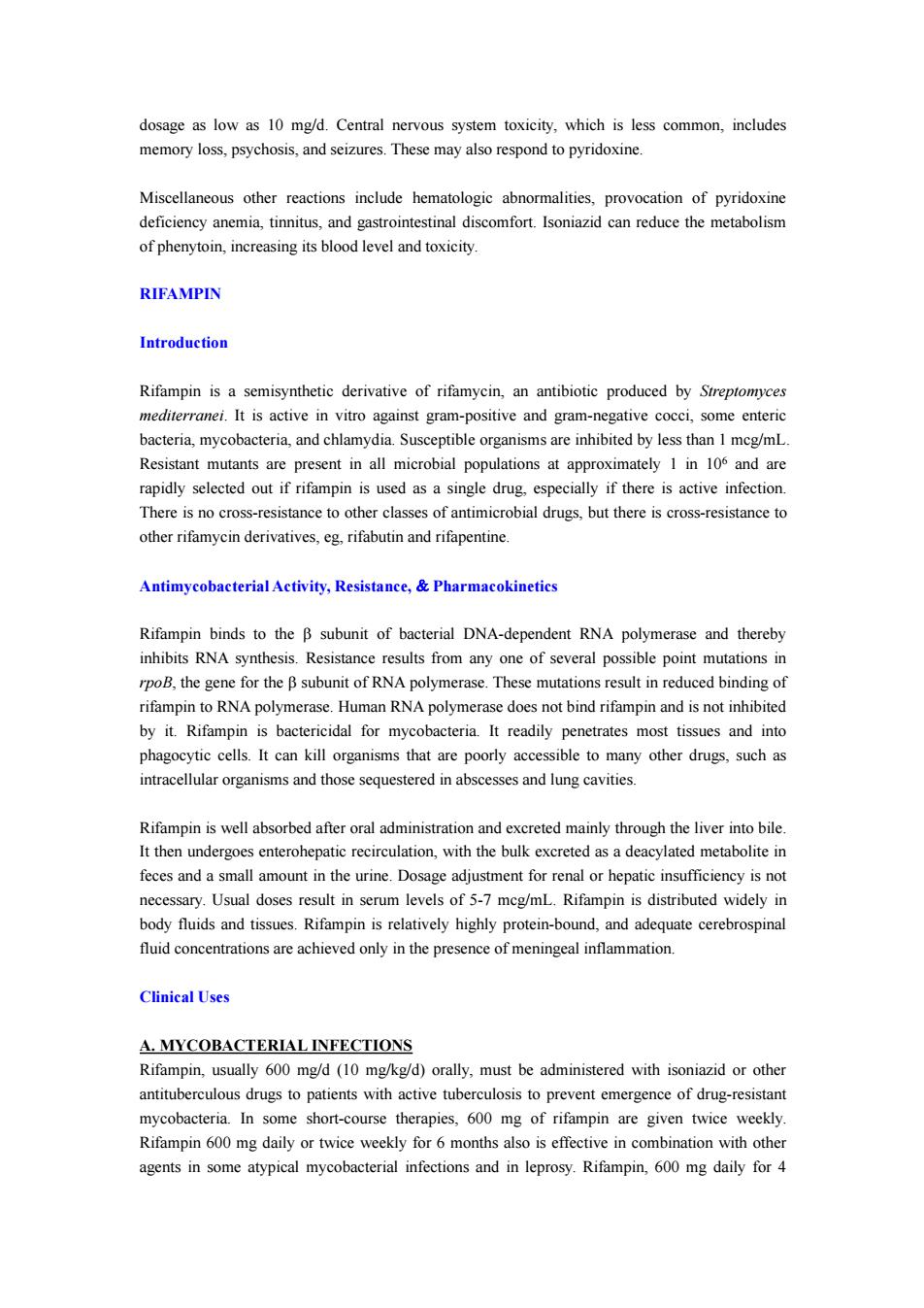正在加载图片...

dosage as low as 10 mg/d.Central nervous system toxicity,which is less common,includes memory loss,psychosis,and seizures.These may also respond to pyridoxine. Miscellaneous other reactions include hematologic abnormalities,provocation of pyridoxine deficiency anemia,tinnitus,and gastrointestinal discomfort.Isoniazid can reduce the metabolism of phenytoin,increasing its blood level and toxicity. RIFAMPIN Introduction Rifampin is a semisynthetic derivative of rifamycin,an antibiotic produced by Streptomyces mediterranei.It is active in vitro against gram-positive and gram-negative cocci,some enteric bacteria,mycobacteria,and chlamydia.Susceptible organisms are inhibited by less than 1 mcg/mL. Resistant mutants are present in all microbial populations at approximately 1 in 106 and are rapidly selected out if rifampin is used as a single drug,especially if there is active infection. There is no cross-resistance to other classes of antimicrobial drugs,but there is cross-resistance to other rifamycin derivatives,eg,rifabutin and rifapentine. Antimycobacterial Activity,Resistance,Pharmacokinetics Rifampin binds to the B subunit of bacterial DNA-dependent RNA polymerase and thereby inhibits RNA synthesis.Resistance results from any one of several possible point mutations in rpoB,the gene for the B subunit of RNA polymerase.These mutations result in reduced binding of rifampin to RNA polymerase.Human RNA polymerase does not bind rifampin and is not inhibited by it.Rifampin is bactericidal for mycobacteria.It readily penetrates most tissues and into phagocytic cells.It can kill organisms that are poorly accessible to many other drugs,such as intracellular organisms and those sequestered in abscesses and lung cavities. Rifampin is well absorbed after oral administration and excreted mainly through the liver into bile. It then undergoes enterohepatic recirculation,with the bulk excreted as a deacylated metabolite in feces and a small amount in the urine.Dosage adjustment for renal or hepatic insufficiency is not necessary.Usual doses result in serum levels of 5-7 mcg/mL.Rifampin is distributed widely in body fluids and tissues.Rifampin is relatively highly protein-bound,and adequate cerebrospinal fluid concentrations are achieved only in the presence of meningeal inflammation. Clinical Uses A.MYCOBACTERIAL INFECTIONS Rifampin,usually 600 mg/d(10 mg/kg/d)orally,must be administered with isoniazid or other antituberculous drugs to patients with active tuberculosis to prevent emergence of drug-resistant mycobacteria.In some short-course therapies,600 mg of rifampin are given twice weekly. Rifampin 600 mg daily or twice weekly for 6 months also is effective in combination with other agents in some atypical mycobacterial infections and in leprosy.Rifampin,600 mg daily for 4dosage as low as 10 mg/d. Central nervous system toxicity, which is less common, includes memory loss, psychosis, and seizures. These may also respond to pyridoxine. Miscellaneous other reactions include hematologic abnormalities, provocation of pyridoxine deficiency anemia, tinnitus, and gastrointestinal discomfort. Isoniazid can reduce the metabolism of phenytoin, increasing its blood level and toxicity. RIFAMPIN Introduction Rifampin is a semisynthetic derivative of rifamycin, an antibiotic produced by Streptomyces mediterranei. It is active in vitro against gram-positive and gram-negative cocci, some enteric bacteria, mycobacteria, and chlamydia. Susceptible organisms are inhibited by less than 1 mcg/mL. Resistant mutants are present in all microbial populations at approximately 1 in 10 6 and are rapidly selected out if rifampin is used as a single drug, especially if there is active infection. There is no cross-resistance to other classes of antimicrobial drugs, but there is cross-resistance to other rifamycin derivatives, eg, rifabutin and rifapentine. Antimycobacterial Activity, Resistance, Pharmacokinetics Rifampin binds to the subunit of bacterial DNA-dependent RNA polymerase and thereby inhibits RNA synthesis. Resistance results from any one of several possible point mutations in rpoB, the gene for the subunit of RNA polymerase. These mutations result in reduced binding of rifampin to RNA polymerase. Human RNA polymerase does not bind rifampin and is not inhibited by it. Rifampin is bactericidal for mycobacteria. It readily penetrates most tissues and into phagocytic cells. It can kill organisms that are poorly accessible to many other drugs, such as intracellular organisms and those sequestered in abscesses and lung cavities. Rifampin is well absorbed after oral administration and excreted mainly through the liver into bile. It then undergoes enterohepatic recirculation, with the bulk excreted as a deacylated metabolite in feces and a small amount in the urine. Dosage adjustment for renal or hepatic insufficiency is not necessary. Usual doses result in serum levels of 5-7 mcg/mL. Rifampin is distributed widely in body fluids and tissues. Rifampin is relatively highly protein-bound, and adequate cerebrospinal fluid concentrations are achieved only in the presence of meningeal inflammation. Clinical Uses A. MYCOBACTERIAL INFECTIONS Rifampin, usually 600 mg/d (10 mg/kg/d) orally, must be administered with isoniazid or other antituberculous drugs to patients with active tuberculosis to prevent emergence of drug-resistant mycobacteria. In some short-course therapies, 600 mg of rifampin are given twice weekly. Rifampin 600 mg daily or twice weekly for 6 months also is effective in combination with other agents in some atypical mycobacterial infections and in leprosy. Rifampin, 600 mg daily for 4